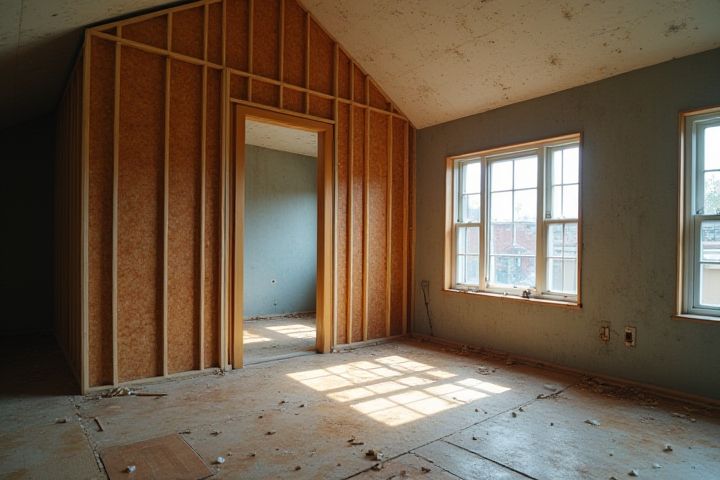
A house can be effectively soundproofed by implementing various construction techniques and materials. Insulating walls with sound-dampening materials such as fiberglass or foam can significantly reduce noise transmission. Installing double-glazed windows enhances sound insulation by creating an air gap that minimizes external noise. Additionally, sealing gaps and cracks around doors and windows with acoustic caulk prevents sound leakage. Creating sound barriers, like thick curtains or dedicated soundproof rooms, can further enhance your home's soundproofing capabilities.
Can A House Be Made Soundproof
Acoustic insulation materials
Acoustic insulation materials play a crucial role in soundproofing a house, effectively minimizing noise transmission between rooms and from external sources. Common materials include mineral wool, which is known for its excellent sound absorption properties, and acoustic panels that can be applied to walls and ceilings for enhanced sound control. You may also consider resilient channels and soundproof drywall, which help decouple wall layers and reduce airborne sound vibrations. By incorporating these materials into your home, you can significantly improve the acoustic comfort of your living environment.
Double-glazed windows
Double-glazed windows significantly enhance soundproofing in a house by utilizing two layers of glass separated by an air gap or gas-filled space, effectively reducing noise transmission. Research indicates that double-glazing can decrease sound levels by up to 30 decibels, making them an ideal choice for homes in noisy environments. By implementing acoustic seals around the frames, you can further improve their soundproofing efficiency. Investing in double-glazed windows not only increases your comfort but also adds value to your property, as many buyers consider noise reduction a desirable feature.
Soundproof doors
A soundproof door can significantly enhance the acoustic properties of a house, reducing noise transmission by up to 90%. These specialized doors are typically constructed with dense materials, such as solid wood or composite materials, which help block sound waves. When installed properly with soundproof seals and door sweeps, they prevent sound leakage around the edges, contributing to a quieter indoor environment. To maximize the effectiveness of soundproofing, consider pairing the door with additional treatments, like acoustic panels or insulation, tailored to your specific noise concerns.
Seal gaps and cracks
To effectively soundproof your house, sealing gaps and cracks is crucial in preventing noise infiltration. Use high-quality acoustic caulk to fill imperfections around windows, doors, and electrical outlets, as these are common sources of sound leakage. Weatherstripping can enhance door seals, while foam tape can be applied to window frames for additional noise reduction. By meticulously addressing these small openings, you can significantly decrease unwanted noise, creating a more peaceful living environment.
Floating floors
Floating floors are an effective solution for soundproofing a house, as they reduce sound transmission between levels. This construction technique involves installing flooring materials on a layer of sound-dampening underlayment, allowing the floor to "float" without being directly attached to the subfloor. By decoupling the floor from the structure, floating floors minimize vibrations and impact noise, making your living space quieter. To enhance soundproofing further, consider adding carpets or rugs on top of floating floors, as they absorb sound and improve overall acoustics in your home.
Sound-dampening curtains
Sound-dampening curtains are an effective solution for enhancing the soundproofing of your home, reducing noise intrusion by up to 30% compared to standard curtains. These specialized drapes often feature multiple layers of fabric with sound-absorbing properties, such as heavy polyester or velvet, designed to minimize sound reflection and transmission. By covering windows and doors with sound-dampening curtains, you can significantly improve your indoor acoustic environment, making it more conducive for activities such as studying, sleeping, or enjoying entertainment. For optimal results, ensure the curtains extend beyond the window frame and use them in combination with other soundproofing measures, like weather stripping and rugs.
Mass-loaded vinyl
Mass-loaded vinyl (MLV) is a highly effective soundproofing material that can significantly reduce noise transmission in a house. With a density of approximately 1 pound per square foot, MLV adds mass to walls, ceilings, and floors, helping to block sound waves. Installing MLV around windows and doors can further enhance sound isolation, making your living space quieter. By integrating MLV into your soundproofing efforts, you can achieve a more peaceful environment, ideal for relaxation or focused work.
Resilient channels
Resilient channels are an effective solution for soundproofing your home, specifically designed to decouple drywall from the structural framing, which minimizes sound transmission. By creating an air gap, these channels reduce vibrations and enhance the acoustic performance of walls and ceilings. Installing resilient channels involves laying them perpendicular to the studs and attaching drywall, allowing for better sound isolation in areas such as bedrooms, home theaters, and music studios. Prioritizing this method in your construction or renovation project can significantly improve your living environment's overall tranquility and comfort.
Wall soundproofing panels
Wall soundproofing panels can significantly reduce noise transmission in your home. These panels often utilize dense materials like fiberglass or foam, which can absorb sound waves effectively, minimizing echo and reverberation. Installing high-quality wall soundproofing panels can lower sound levels by up to 50%, enhancing your privacy and comfort. When choosing panels, consider options with a Noise Reduction Coefficient (NRC) rating of 0.7 or higher for optimal performance in sound insulation.
Importance of room layout
Effective soundproofing in a house significantly relies on thoughtful room layout, as strategic placement of living spaces can minimize noise transmission. For instance, positioning noise-sensitive areas, such as bedrooms and offices, away from noisy zones like living rooms or home theaters enhances acoustic comfort. Utilizing materials like mass-loaded vinyl or acoustic panels in the construction of interior walls can further dampen sound waves, making layout decisions even more impactful. Ensure that doors and windows, which account for approximately 70% of sound leakage, are properly sealed or upgraded to enhance your home's overall soundproofing effectiveness.
